Papers by Negin Banaeianjahromi
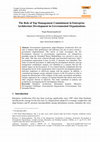
Complex Systems Informatics and Modeling Quarterly, 2018
Governmental organizations adopt Enterprise Architecture (EA) not only to enhance their performan... more Governmental organizations adopt Enterprise Architecture (EA) not only to enhance their performance and efficiency but also to move toward e-government implementation. The article at hand investigates the EA development obstacles in governmental organizations. An interpretivist paradigm using the Grounded Theory Methodology was selected to carry out this study. The data were collected through semi-structured interviews with 9 governmental organizations in Iran. In total, 17 obstacles were identified. This study revealed the precedence in addressing EA development obstacles and top management commitment category was identified as a category that has the highest impact on the EA projects. It was realized that the commitment that top management levels of the organizations show toward EA development projects, motivates employees to effectively engage with the projects. In addition, a committed top manager assigns adequate resources to the EA project in order to prepare the infrastructure of the company. In this study, government and politics category appeared to be a category of external obstacles that affects most of the other categories directly or indirectly. This study contributes to industry and academia by investigating the EA development obstacles.
Proceedings of the 52nd Hawaii International Conference on System Sciences, 2019
Communication and collaboration in Enterprise Architecture (EA) development have always been chal... more Communication and collaboration in Enterprise Architecture (EA) development have always been challenging. This paper contributes to the field of EA by investigating the factors that influence communication and collaboration in EA development. Data was collected from 14 large organizations in various industries regarding their EA development. Adopting the grounded theory method, we identified 20 factors that influence communication and collaboration in EA development and further categorized them into social, technical, internal, and external. Moreover, we analyzed and theorized the relationships between the factors to realize how they influence each other. Analyzing five organizational documents, we provide recommendations to improve communication and collaboration in EA development.

Enterprise architecture (EA) is widely employed to reduce complexity and to improve business–info... more Enterprise architecture (EA) is widely employed to reduce complexity and to improve business–information technology (IT) alignment. Despite the efforts by practitioners and academics in proposing approaches to smoothen EA development, it is not easy to find a fully successful EA. Because EA development is a complex endeavour, it is important to understand the obstacles that practitioners face during EA development. With the grounded theory, we studied how obstacles during EA development emerged from practitioners’ point of view in 15 large enterprises. The study identifies lack of communication and collaboration as the core obstacle that can explain many other obstacles. Communication and collaboration were also harmed by other perceived EA development obstacles, including lack of knowledge and support inside organization and issues imposed by external parties, hesitation in training personnel, setting too ambitious goals, constant change of management, (lack of) clarity in EA development process, lack of budget, forcing personnel to adopt EA, lack of motivation, organizational culture, and organizational structure deficiencies. The lack of communication and collaboration caused several undesired effects to organizations, such as being unable to set common goals and achieve a shared understanding, personnel’s distrust, endangered EA governance, lack of innovation capability, lost competitive edge, and ineffective EA outputs. The study highlights that organisations should improve their communication and collaboration before embarking on EA to encounter fewer obstacles. We provide four recommendations for practitioners to improve communication and collaboration in EA development.
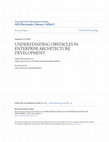
Today’s enterprise environment is more sophisticated than ever and being able to manage this comp... more Today’s enterprise environment is more sophisticated than ever and being able to manage this complexity is not possible without having a planned approach. Enterprise architecture (EA) has emerge as a planned approach to mitigate the organizational complexities and control the constant environmental changes. How-ever, despite the numerous EA development step-by-step methods and approaches not all of the EA efforts end with success. In this study we aimed to identify the obstacles that endanger the EA projects. Employing the multiple case study research method we collected data from 14 large enterprises by interviewing 20 experts. In total, we identified 20 obstacles that we further categorized into four main themes. Compared to earlier literature we found five types of obstacles that have not been mentioned before: political issues of the government, EA consultant related issues, outdated organizational statutes, constant change of management, and inefficient human resource department. Further we discussed about the relationships among the identified obstacles and provide advice for managers to reduce the obstacles during EA development. Because this study is based on real world cases, provided understanding can benefit practitioners to alleviate obstacles during EA development.
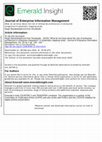
Purpose: Constant changes in the environment seem to have become the biggest challenge of a moder... more Purpose: Constant changes in the environment seem to have become the biggest challenge of a modern enterprise, which emphasizes the constant need to integrate the enterprise into its changing environment. Aiming at eliminating the integration challenges, EA is proposed as a solution. The objective of this study is to survey and analyse the available literature on determining the role of EA in EI and also to identify gaps and state-of-the-art in research.
Design/methodology/approach: This paper presents a systematic mapping study that found 50 papers in the intersection of EA and EI, these papers were surveyed, analysed, and classified with respect to research focus, research method, and paper type.
Findings: Based on the analyses of the final 50 articles, we realized that “EA framework” is the dominating research focus of these studies. “Evaluation research” is recognized as the most common paper type in this area. However, “Experience paper” was a rare paper type in this research domain. “Constructive research” and “Case study/Multiple case studies” are widely applied as the research method. “Survey”, “Delphi study”, and “Grounded theory” are the least employed research methods. Our conclusion was that there is a need for empirical research in this area. After analysing the articles based on their publication year, we also noticed a significant growth between 2004 and 2010. After 2010 the number of publications had a downward trend.
Originality/value: To the knowledge of the authors, this study is the first systematic literature study regarding the role of EA in EI. There are several systematic literature reviews (SLR) about the EA or EI separately but none of them has addressed the specific realm of our research. Hence, the goal of this study is to provide a map of existing literature to enable improvement of the practice with the known research results and to identify gaps for future research.
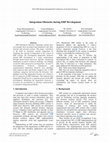
ERP (Enterprise Resource Planning) systems have increasingly been developed and integrated ... more ERP (Enterprise Resource Planning) systems have increasingly been developed and integrated with other internal and external systems. This paper contributes to the field of enterprise systems integration by clarifying the concept of integration in the context of ERP systems. We investigated integration obstacles during ERP development in 5 large organizations through theme-based interviews. Besides considering integration as purely technical challenge, our findings reveal the other perspectives of integration. In total 31 environmental, technical, managerial, and organizational integration obstacles were identified from empirical data and further mapped with 13 ERP challenge categories derived from the literature. Our findings reveal that integration barriers are related to all 13 categories of ERP challenges. This indicates that integration should not be a separate project from ERP development. Identifying the integration obstacles is necessary for practitioners to develop counteractions to enterprise integration problems.
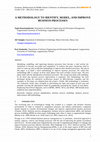
European, Mediterranean & Middle Eastern Conference on Information Systems 2014 (EMCIS2014) October 27th – 28th 2014, Doha, Qatar, Oct 27, 2014
Identifying, modelling, and improving business processes have become a vital activity for enterpr... more Identifying, modelling, and improving business processes have become a vital activity for enterprises to become successful and competitive. To achieve this goal, enterprises need to select or come up with an efficient methodology to improve their business processes. The aim of this paper is to build a novel methodology to improve business processes. We called this methodology IMI. It consists of three main phases that each includes several steps. The first phase deals with the identification of business processes. The second step deals with modelling. In the third step business process improvement is explained. This methodology has been developed during the enterprise architecture project of AbFa-Kerman Company and the examples in this paper are adopted from this project. Finally, IMI methodology is evaluated. The evaluation results show strengths in determining the input and output of each step and partially covering the information model by graphically presenting the results of each phase. Employing hierarchical diagrams, such as BPML, SIPOC, WCA, and APQC, IMI benefits from simplicity and comprehensibility.

European, Mediterranean & Middle Eastern Conference on Information Systems 2014 (EMCIS2014) October 27th – 28th 2014, Doha, Qatar, Oct 27, 2014
Enterprise architecture (EA) and enterprise integration (EI) are important topics to any enterpri... more Enterprise architecture (EA) and enterprise integration (EI) are important topics to any enterprise around the globe. Constant changes in the environment seem to have become the biggest challenge of a modern enterprise, which emphasizes the constant need to integrate the enterprise into its changing environment. Aiming at eliminating the integration challenges, EA is proposed as a solution. The objective of this study is to survey and analyse available literature on determining the role of EA in EI and also to identify gaps and state-of-the-art in research. This paper presents a systematic mapping study that found 50 papers in the intersection of EA and EI, these papers were surveyed, analysed, and classified with respect to research focus, research method, and paper type. Based on the analyses, “framework and conceptual model” is recognized as the most common applied research method and “evaluation research” as the most common paper type. Furthermore, majority of papers that develop “framework and conceptual model” are based on “validation research”, that is, they are not evaluated or implemented in practice. Based on the analysis, “interview” and “survey” are the two least applied research methods and “experience papers” is recognized as the least used paper type.

Uploads
Papers by Negin Banaeianjahromi
Design/methodology/approach: This paper presents a systematic mapping study that found 50 papers in the intersection of EA and EI, these papers were surveyed, analysed, and classified with respect to research focus, research method, and paper type.
Findings: Based on the analyses of the final 50 articles, we realized that “EA framework” is the dominating research focus of these studies. “Evaluation research” is recognized as the most common paper type in this area. However, “Experience paper” was a rare paper type in this research domain. “Constructive research” and “Case study/Multiple case studies” are widely applied as the research method. “Survey”, “Delphi study”, and “Grounded theory” are the least employed research methods. Our conclusion was that there is a need for empirical research in this area. After analysing the articles based on their publication year, we also noticed a significant growth between 2004 and 2010. After 2010 the number of publications had a downward trend.
Originality/value: To the knowledge of the authors, this study is the first systematic literature study regarding the role of EA in EI. There are several systematic literature reviews (SLR) about the EA or EI separately but none of them has addressed the specific realm of our research. Hence, the goal of this study is to provide a map of existing literature to enable improvement of the practice with the known research results and to identify gaps for future research.
Design/methodology/approach: This paper presents a systematic mapping study that found 50 papers in the intersection of EA and EI, these papers were surveyed, analysed, and classified with respect to research focus, research method, and paper type.
Findings: Based on the analyses of the final 50 articles, we realized that “EA framework” is the dominating research focus of these studies. “Evaluation research” is recognized as the most common paper type in this area. However, “Experience paper” was a rare paper type in this research domain. “Constructive research” and “Case study/Multiple case studies” are widely applied as the research method. “Survey”, “Delphi study”, and “Grounded theory” are the least employed research methods. Our conclusion was that there is a need for empirical research in this area. After analysing the articles based on their publication year, we also noticed a significant growth between 2004 and 2010. After 2010 the number of publications had a downward trend.
Originality/value: To the knowledge of the authors, this study is the first systematic literature study regarding the role of EA in EI. There are several systematic literature reviews (SLR) about the EA or EI separately but none of them has addressed the specific realm of our research. Hence, the goal of this study is to provide a map of existing literature to enable improvement of the practice with the known research results and to identify gaps for future research.